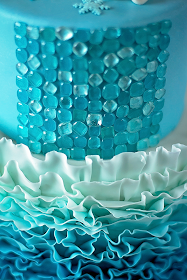NOTE: Sara’s blog has moved to a new location: http://saraelizabethcakes.com. Feel free to browse around my tutorials here, then come check out my new site!
The Disney "Frozen" Fever might finally be settling down to more of a dull roar, but requests for Frozen birthday parties and birthday cakes are still going strong! After the popularity of my last Frozen cake made for the amazing Icing Smiles charitable organization, I was really excited to create another, smaller Frozen-themed cake that incorporated some key elements of the last one, with some new twists.
Here were my design elements that I wanted to include:
1) Elsa's Crown
2) Isomalt Sugar Gems
3) Blue Ombre Fondant Ruffles
4) Fondant Snowflakes
5) Incorporate the pink from Ana's Cloak
 |
| My last frozen cake -- view tips and more photos on my previous blog post! |
For my last cake, I loved recreating the Olaf and the snowflake toppers. This time, I was excited to see just how close of a replica I could make to Elsa's crown. I began by drawing out my own template, based on pictures from the movie. It takes about 8-10 drawings, re-drawings, and tracings of my own drawing for me to create a symmetrical, fine-tuned final template.
This template works great for fondant or gumpaste crown toppers, but it can also be used with paper to create your own Elsa's crown to wear at a party, around the house, at work, on a date, etc . . . ;)
If making this delicate crown from paper, I would use a very heavy paper, and cut the bottom band a good bit wider to provide more stability.
The making of this crown is, in most ways, exactly identical to my other Crown Tutorial, so I'm not going to go as in-depth in this post. Hop back over to that post for more details, including a link to a great Isomalt gem tutorial!
Laying the template onto a thin, rolled out piece of dark yellow-tinted gumpaste, I used a brand new disposable scalpel to trace around the edges of the crown template, cutting it out of Wilton's Gumpaste. Gumpaste gets much harder, much faster than fondant does (even fondant with added Tylose), so I much prefer using it for something with this much height and fine detail. I also find it easier to cut, without tugging or pulling out of shape due to the drag of my knife.
Once cut, I carefully wrapped it around a large can that I had previously covered in Glad Press and Seal Wrap.
 |
| Vodka, clean paint brush, CK's Gold Highlighting Dust -- ready to paint! |
Once it has had at least several hours (or overnight) to dry, it's time to add some gold! Using my gold dust, a touch of vodka, and a clean brush used only for food, I can make my crown appear golden! Some day I'll get an airbrush set to create that perfect golden finish, but for now, a brush suffices. I typically do at least 2 coats, allowing the gold to dry in between coats.
I kept the crown on the can while I painted the all-over coat of gold, just in case the liquid weakened the thin gumpaste, which could cause it to soften and droop out of shape. If you don't have access to some cheap vodka, clear flavoring extracts work as well, due to the high alcohol content. The alcohol from either one evaporates entirely, so no worries of getting any one tipsy! Why do we want the alcohol? It evaporates and dries much more quickly than water, which preserves the integrity and strength of your gumpaste or fondant.
Once it felt very dry and solid, I gently removed it from the can, carefully peeled off the Saran Wrap, and let the crown air dry on a large yellow sponge (shown in my other crown tutorial). It's best to give it at least a couple days to completely dry out. I made my crown at the beginning of the week for a cake due on Saturday.
For the final touch, I added a shiny blue Isomalt gem in the center, using a touch of Royal Icing as glue, which I also painted gold once dry. I love this Royal Icing recipe from Sweet Sugarbelle. You can save the extra for some awesome Sugar Cookies inspired by her wonderful blog!

Finito!
One lovely Elsa Crown, ready to adorn your latest creation . . . or your head. I won't tell.
Happy Caking!




















































